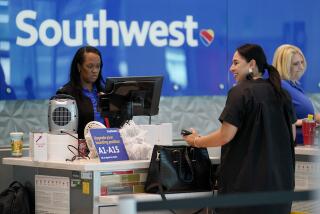Airlines plan slower growth, cost cuts to offset fuel prices
- Share via
Several major airlines outlined plans Tuesday to slow their growth and cut costs to deal with higher fuel prices and the prospect of an economic slowdown that could hurt air travel.
Executives at some carriers also said they were actively planning for airline mergers, although they were careful not to discuss specific combinations.
“We are not standing around waiting for consolidation to happen. We’re interested in that,” said Jake Brace, chief financial officer of United Airlines.
Brace said United, a unit of Chicago-based UAL Corp., had no plans to expand its flying in the highly competitive U.S. market but intended to expand about 15% internationally over the next three years.
Atlanta-based Delta Air Lines Inc. is also looking to increase its international flying from 25% of capacity in 2005 to 40% next year.
After heavy losses from 2001 through 2005, U.S. airlines have returned to profitability. They had a great summer vacation season. Third-quarter earnings were the best in several years, as planes were nearly full and passengers paid higher average fares than they did in summer 2005.
But the big traditional carriers are facing ever-tougher competition from low-cost carriers that are expanding rapidly and holding down fares.
Executives of the big carriers warned that their comeback is threatened by high fuel costs and uncertainty over the economy.
“We are concerned about growing evidence of slowing economic growth that would inevitably affect passenger demand, coupled with a surge in energy prices,” Southwest Airlines Co. Chief Executive Gary C. Kelly said.
Kelly’s comments came as Dallas-based Southwest announced that its capacity would grow 4% to 5% next year.
It had initially forecast growth of 8% and later scaled back to 6%.
Southwest also reported that November traffic grew 2.6%, measured by miles flown by paying passengers. That growth, however, failed to keep up with a 6.4% increase in capacity.
As a result, average occupancy on Southwest flights slipped to 69.3% from 71.8% in November 2006.
Those results mirrored numbers late Monday from Houston-based Continental Airlines Inc., which also cut its growth expectations for 2008 to 2% to 3%, down from 3% to 4%.
The entire increase will be international -- the carrier said it would shrink domestic capacity.
Continental also said its average occupancy or “load factor” in November slipped 0.7% to 80.4% from last November.
“Our load factors are still pretty good,” Continental’s chief financial officer, Jeff Misner, said Tuesday at an investor conference in New York.
“I’m not sure we’re ready to declare a downturn by any stretch.”
Misner added that when the industry’s next slump hit, it wouldn’t be as bad as previous ones because carriers had cut costs, allowing them to earn profits even at current high fuel prices.
Also, he said, fares have less room to fall than they did a few years ago.
More to Read
Inside the business of entertainment
The Wide Shot brings you news, analysis and insights on everything from streaming wars to production — and what it all means for the future.
You may occasionally receive promotional content from the Los Angeles Times.










